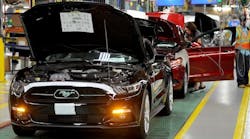Look out for these major developments in the coming year:
1. Connected Cars Move Ahead
The Uber generation is here. Brand loyalty is becoming a thing of the past as millennials and those even younger explore long-term leases and car sharing. For these new consumers, digital capabilities will be a key differentiator. Which services, networks and data can they access? How enabled will their vehicle be? A premium range of apps and digital functions are now expected as standard, with the latest models still selling primarily on power and weight.
Many IT requirements will become mandatory by 2018, and manufacturers will need to take this into account. In the US it will become law to have a rear camera. Every year in the U.S., approximately 200 people are killed and 14,000 injured in back-over accidents.
For most manufacturers, rear cameras are already a priority. By 2017, 80% of all manufactured cars will have one. Back-up cameras are included on around half of all new cars sold in the U.S. today. Wi-Fi hotspots in vehicles, too, are on the road to becoming standard, with 20% of car manufacturers planning to provide WLAN hotspots in vehicles in 2017.
2. Electric Vehicles Power the Future
The alternative fuel market will reach $614 billion by 2022. The Asia-Pacific region is continuing to corner this market, especially in China. In July 2016, the market share for electric vehicles (EV) in China broke through the 1% barrier, up to 1.1% of all new car sales. Although this may not sound like much, 1.1% meant 34,000 new EVs on Chinese roads in July 2016, a 188% increase over June.
Central to China’s success has been its network of charging stations. Between 2010 and 2015, the number of charging stations in China grew from 1,122 to 49,000. Factor in privately owned charging stations and stations for buses and logistics vehicles, and the total number of stations reached 160,000. The country aims to build 12,000 centralized charging stations and 4.8 million provincial charging stations by 2020, to meet a forecast demand of 5 million EVs. A robust strategy for charging stations is essential for EV uptake.
This could bring about new opportunities for manufacturers in all regions. In 2017, we could well see European and U.S. manufacturers increase their presence in China around advanced safety technology and crash testing. China is already coming to Europe to test many of its domestic car models. In 2017 and beyond, European manufacturers will help China develop its safety and testing capabilities—as China continues to showcase the benefits of a robust, comprehensive EV strategy.
3. New Materials Race Heats up
Formula One is a hothouse for the development of ultra-high-speed, ultra-light-weight, tough, crash-resistant materials. In 2017, materials and technologies developed in Formula One will keep transitioning into mainstream serial manufacture. Cost is a key issue for OEM producers, but many are already achieving increased quality while reducing costs. 2016 has seen excellent advances in serial vehicles that are safer, lighter and more powerful. In 2017 we’ll see even more. The use of new and innovative materials shows the serious competitive edge large-scale manufacturers get when they learn closely from smaller, high-end, innovative manufacturers.
But new materials are only half the story. New vehicles mean new processes. The growth of EVs and hybrids mean many manufacturing processes are being turned on their head. In EVs and hybrids, the battery is one of the last parts to be installed—a complete reversal of traditional processes. For suppliers and manufacturers, automation and new processes will power their competitive edge. Manufacturing plants like Tesla’s, that have several automated stations rather than a traditional sequential line, will become the norm. The Tesla plant employs 3,000 people and 180 highly versatile, specialized robots. Process efficiency drives everything.
In 2017 we will see the backbone of auto manufacturing—the production line—streamline, automate and diversify at even greater speed as manufacturers and suppliers race to produce lighter more powerful vehicles faster. The effects will spread throughout the supply chain. Suppliers, too, will need to be more innovative, faster and more agile—often transforming their logistics and production processes as smaller, more technologically advanced suppliers start challenging older ones. Speed of development, production and supply will be of the essence in the new year.
Lighter, faster, more powerful and safer—manufacturers are constantly changing our understanding of what a ‘car’ is, what we can do in it and how we power it. For manufactures and suppliers, this means new directions, new processes, new capabilities and new strategies—and the sooner the better.
This article was originally published on IndustryWeek, a companion site of American Machinist and part of Penton's Manufacturing & Supply Chain group.





